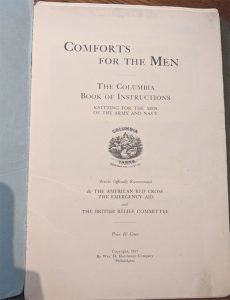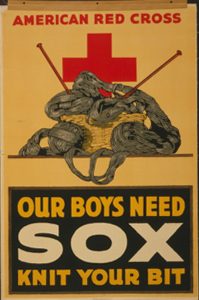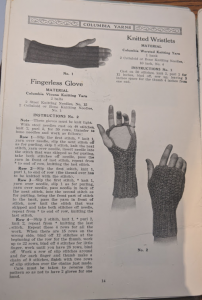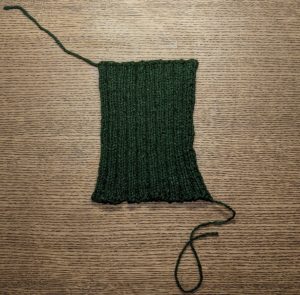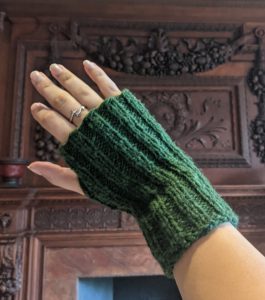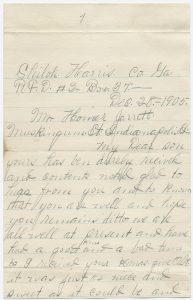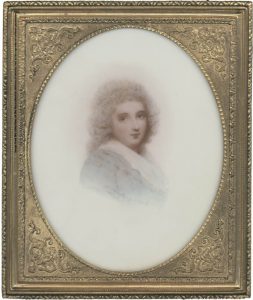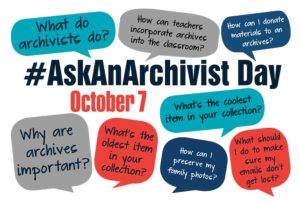Alexandra Bush, Digital Production Specialist
This October, current events dictate that we must keep our tricks and treats indoors. Fortunately, working at the MHS provides more opportunities to get scared than one might think. Read on for some short glimpses into the more macabre side of the MHS and its collections.
Close Encounters of the Winthropian Kind

“When it stood still, it flamed up, and was about three yards square; when it ran, it was contracted into the figure of a swine: it ran as swift as an arrow towards Charlton, and so up and down about two or three hours.”
The three men, who were in a boat at the time, had been paddling downstream when they saw the strange light. After it vanished, they inexplicably found themselves “carried quite back against the tide to the place they came from.” The second event occurred a few years later, in 1644, when three men approaching Boston in a boat at night saw two lights rise from the water, coalesce into the form of a human figure, and walk south. A week later, the lights returned:
“Sometimes they shot out flames and sometimes sparkles… About the same time a voice was heard upon the water between Boston and Dorchester, calling out in a most dreadful manner, boy, boy, come away, come away: and it suddenly shifted from one place to another a great distance, about twenty times.”
Winthrop offers no explanation of the first account, but of the second he postulates that the disembodied voice is that of a man involved in the explosion of a ship in that same area of the bay. Before he died, the man “professed himself to have skill in necromancy.” After the ship burned, his body was the only one that was not recovered.
Another Creepy-Crawly Diary Entry
John Quincy Adams’ lifelong diary is similarly touted as an invaluable account of life in early America as part of a prodigal family. JQA covers a wide range of topics with a uniquely vivid voice. This description of a spider’s nest in his bed is positively shiver-inducing:
“IV: I passed the night without closing my eyes, under a perpetual irritation of the skin over my face and almost every part of the body, which I supposed to be the effect of what is called prickly heat— But on changing my linen this morning I discovered it was caused by a nest of Spiders just from the egg-shell, so small that most of them were perceptible only by their motion. It was like the continual titillation of a feather passing over the skin at a thousand places at once— It was a night of exquisite torture without pain— My linen and body were covered with them. I immediately stripped, changed all the clothes I had been wearing, and took a warm bath at Burnside’s. How this horrible creeping Nation got upon me, I could not exactly ascertain— They had already produced a cutaneous inflammation, and almost an eruption in various places…”
Portrait of a Serial Killer

On 7 May 1876, Thomas W. Piper, the well-respected sexton of Boston’s Warren Avenue Baptist Church, confessed to the murder of 5 year-old Mabel Young in the belfry of his church. Under the pressure of two days’ worth of intense questioning, Piper also confessed to several cases of arson as well as two earlier crimes; the assault of prostitute Mary Tyner with a blunt object, and the murder of domestic servant Bridget Landregan. Known for his high level of literacy and his trademark flowing black cloak, Piper was spotted fleeing the scene of Mabel Young’s murder by a man identified in the case notes as “Glover.” Later on, when Glover heard the news of the murdered girl, he connected the two events and took the information to the police. Throughout the trial and confession, Piper retained an air of detached apathy, only becoming nervous once he was convicted. He was hanged for his crimes on 26 March, 1876.
Walter L. Sawyer, one of the witnesses to the trial, compiled a scrapbook of drawings, photographs, and newspaper accounts immortalizing the man who would come to be known as the “Boston Belfry Murderer.”
Poor Rebeccah
There’s no scary story behind this item, but several MHS-ers insisted that she belongs on this list. In fact, her provenance is quite idyllic. “Rebeccah Codman Butterfield” is a doll, likely made by a member of the Codman family, part of the Transcendentalist community Brook Farm of West Roxbury, Massachusetts. A note pinned to her petticoat, penned by her donor’s mother, reads:
“My name is Rebeccah Codman Butterfield. I was born in 1841. My mother made me and I was the darling of the Brook Farmers & their children. Brook Farm was called The Transcendentalists. I grew up with the Alcotts, George Ripley, John S [Dwight], Margaret Fuller, Ralph Waldo Emerson, Henry Thoreau, William Ellery Channing, Elizabeth Peabody & Nathaniel Hawthorne–no wonder I look a bit cracked! I was the doll for all the Butterfield children & a beloved member of that brilliant colony.”
How sweet! One of our Reference staff, also a member of the group who suggested Rebeccah for this list, fondly remembers retrieving artifacts under her watchful eye while she was living in the stacks.

Hallowed Halls
The MHS’ vast archival collections notwithstanding, our building at 1154 Boylston Street has weathered its fair share of history. Although this is the society’s seventh location since its founding in 1791, we have resided in the current space for over 120 years. A large addition was built onto the MHS in 1970, expanding the office and collection storage space by filling in the middle of the original, L-shaped building. As many in the archives field can attest, old buildings packed with decades of personal papers carry with them an innate weight—a sense of presence. Below, MHS employees recount unexplainable occurrences within our building.
Independently of one another, two MHS veterans mentioned the clear sound of footsteps from the stacks. One recalled conversations with past Operations staff, who swore they heard “measure footsteps back and forth” while they cleaned the building after hours. The other described how the wooden floors (now concrete) used to creak and groan near the areas where the new addition connected to the original building. The footsteps, he said, sounded like an echo of his own as he walked the aisles. He wondered if the sound could be attributed to the previous owners of our various collections, trailing behind the remnants of their legacies. Or perhaps, after nearly 230 years, MHS founder Jeremy Belknap still felt the need to act as steward to his treasured collection.
Stories like this tend to pile up when speaking to Operations staff and other employees who often find themselves in the building at night. Several people remember an event in the early 2000s, when an arm of the crystal chandelier hanging in the lobby crashed to the floor in the dead of night. The CCTV camera footage from just before the arm fell showed the chandelier swinging back and forth as if pushed by an unseen force—the only movement in a completely dark, silent room. When asked, the Art and Artifact Curator had a perfectly sound explanation; after a faulty repair job, “the weight of the crystal beyond the pin and cement join proved too heavy and failed and slowly separated from the end plugged into the chandelier base. The shifting weight was enough that the finely balanced chandelier to start swinging and when the arm fully separated and fell, that made the swinging wider.” As to what caused the arm to separate on that day specifically, there is no answer.

The other group that probably deals with the bulk of experiences like this is the Reference staff—in other words, the ones who most frequently delve into the stacks. Anyone who has spent time in library stacks can attest to their eeriness. Cold air and row after row of floor-to-ceiling shelving, interspersed with portraits, busts, and mannequins, greet anyone stepping into the MHS stacks. One Reference staff member remembers working one winter, during which she spent long hours completely alone in the stacks:
“For the most part it was just eerie. Being superstitious means I have always kind of viewed the collections as alive to a certain extent, and I just try to treat them with as much respect as possible. Several times while in the stacks I would hear random sounds—sometimes wall tapping or sometimes banging sounds. I recall one time I’d gotten particularly on edge, and I said out loud, “Unless you’re going to come out here and help me with this, give it a rest.” Nothing came out to help, but the noise subsided for a while. And I’m sure I don’t have to tell you about the intense feeling of unease I would get every time I was close to that rocking bassinet. One time I thought I saw it moving. That thing has always given me the creeps. Otherwise not much happened, just a mixture of eerie silence and varied clanging sounds.”
The staff member quoted above would often talk with another staff member about that cradle, but research into it has yielded overwhelmingly normal results. However, the former staff member remembers another encounter:
On a dark, rainy Saturday, she received a paging request from one of the few researchers in the building that day. The requested pamphlet described the 1850s construction of the Hoosac Tunnel, a project so fraught with accidents that the tunnel was nicknamed the “Bloody Pit.” Over the course of the 20+ year construction, a total of 196 workers died in explosions, cave-ins and floods. Haunted by the surprising content of the volume, the staff member ventured to find the pamphlet, tucked with others like it at the very end of a row of rolling high-density shelves. She wheeled the shelves apart, slipped between them, and followed the call numbers to the back wall. There, on an envelope—“The Hoosac Tunnel Disaster.” In spite of herself, she stopped to scan the shelf, choosing another volume and opening it to read a few pages. Accounts of cave-ins and suffocating workers nearly distracted her from the moving shelf behind her, closing by itself due to uneven flooring, until it had nearly crushed her. The uneven flooring argument makes sense, of course, but this was first time the shelves had done this in her several months of work.
Wishing everyone a safe and happy Halloween!
References
John Winthrop’s Journal, “History of New England,” 1630-1649. Pg. 154, 294.
John Quincy Adams Diary, volume 30. 22 August 1818. https://www.masshist.org/publications/jqadiaries/index.php/document/jqadiaries-v30-1818-08-22-p382
COMMONWEALTH vs. THOMAS W. PIPER. 120 Mass. 185. 20 March 1876. https://law.justia.com/cases/massachusetts/supreme-court/volumes/120/120mass185.html
New-York tribune. [volume] (New York [N.Y.]), 09 May 1876. Chronicling America: Historic American Newspapers. Lib. of Congress. https://chroniclingamerica.loc.gov/lccn/sn83030214/1876-05-09/ed-1/seq-4/


